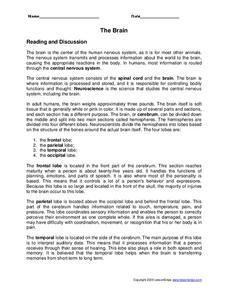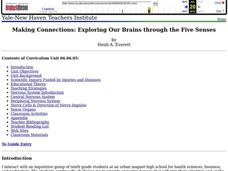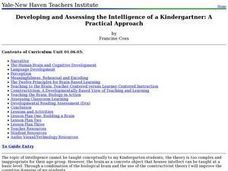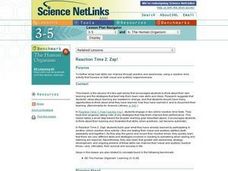Curated OER
The Brain
In this brain worksheet, students read about the brain, its four parts, and their functions, and answer comprehension questions. In this fill in the blank and true and false worksheet, students answer thirteen questions.
Curated OER
Making Connections: Exploring Our Brains through the Five Senses
Students identify structures of the brain, and neurons and analyze their functions. For this nervous system lesson students create drawings and models of anatomy.
Curated OER
The Human Body Lesson
Students identify features of the human body, explore needs of the human body by explaining the importance of good health in relationship to the body, and study functions and care of the human body and its organs.
Curated OER
Human Body Simon Says
Students display their new knowledge of human body parts' names and locations, by playing an adaptation of the game Simon Says. A more sophisticated version of the game can be played with older students as they learn more specific names...
Curated OER
Making and Using a Gel Person to Teach Human Anatomy
Students investigate organs, anatomical planes and transverse sections of the human body using gel people. In this human anatomy lesson plan, students use gel molds, gel and food items to make models of the human body. They create a...
Curated OER
The Nervous System
Human biology beginners label colorful diagrams of the neuron, the reflex pathway, and the brain. They list steps in the action potential process, and describe several different neurotransmitters. This worksheet guides learners through...
University of Minnesota
Memory Items
Ready to have an "unforgettable" time in science class? Try a fun and insightful activity, suitable for a wide age group of learners. Explore how human memory works when pupils try to remember objects they've seen before comparing the...
Curated OER
Left Brain vs. Right Brain -- Which Side Are You On?
Students examine the different regions of the brain and what they are responsible for. They decide whether they are right or left- brain dominant based on their personalities.
Curated OER
Sheep Brain Dissection
Students study the brain and examine what the functions of the major functions are. In this investigative lesson students dissect a sheep's brain and note the similarities and differences between it and a humans brain.
Curated OER
GED Vocabulary: Life Science
In this life science GED worksheet, students complete a crossword puzzle given 9 clues about structures of the nervous system, the circulatory system, evolution, the digestive system, molecules and fossils. Students are given a word bank...
Curated OER
GED: Vocabulary: Life Science
In this GED vocabulary worksheet, students complete a crossword puzzle given 10 clues about genetics and cloning, food chains, vaccines, the brain and the nervous system and organisms. Students are given a word bank to use to complete...
Curated OER
Nervous System
Get to know the body's central nervous system through an engaging game of nervous system telephone. But this isn't your average game of telephone. Here, pupils must find a way to communicate a message to the brain without speaking....
Curated OER
Studying Fossils
Students compare and contrast key skeletal differences between chimpanzees and humans: brain size, teeth, hand and thumb, trunk, pelvis, lower limb, foot and big toe. They then sort and group a set of mixed "fossil bones" of chimpanzee...
Curated OER
Bones Provide Great Support!
How do bones help people move around? A science investigation prompts kids to draw arrows to certain bones that protect their organs. After they finish, they trace their hands on a piece of paper and trace the way their bones go. Great...
Curated OER
AP: Chapter 48: Nervous System
Human anatomy enthusiasts trace neurological pahtways in word and on a diagram, describe action potential of a nerve impulse, and identify the organs in the nervous system. Provide this to your biology class as a review before...
Howard Hughes Medical Institute
Explore Your Inner Animals
Human bodies prove evolution thanks to our genes, bones, and more. Learning about specific body parts and how they evolved from other species helps individuals better understand the transition species that helped us become who we are today.
Curated OER
Developing and Assessing the Intelligence of a Kindergartner: A Practical Approach
Students name objects that are the same size, shape, and weight as the human brain. They touch the model brain, feeling the folds, etc. They make connections to the chart displaying the brain-like objects. They touch the 'potato flake'...
Curated OER
The Human Body: Bones
Here is an interactive PowerPoint about the skeletal system. The first slide shows the entire skeleton and allows learners to try to name each major bone structure before clicking to show the answer. The following slides provide more...
Curated OER
Reaction Time 2: Zap!
Learners explore critical thinking by conducting a reaction time experiment. In this human brain lesson, students utilize a timed Internet worksheet activity to research how fast their brain works when answering questions. Learners share...
Scholastic
Study Jams! The Senses: Tasting
Mmmmmmm, here is a tasty little slide show to use when introducing upper-elementary learners to the sense of taste. Photographs and detailed computer images accompany explanatory text about how the taste buds and the nose send signals to...
Virginia Department of Education
Cell Parts
What do a bird, an egg, a rabbit, and a toad all have in common? This fun-filled resource explains the similarities and differences between cells and how all cells are similar, yet all are different. Learners begin by depicting a...
Scholastic
Study Jams! The Senses: Seeing
What will viewers see when they watch this video about vision? They will observe RJ and Sam hanging out during a power outage with Rookie, the dog. The boys discuss the structure of the eye (pupil, iris, cornea, lens, retina,...
Curated OER
Anatomy of the Brain
Students explore human anatomy by completing a quiz. For this brain lesson, students read assigned text which discusses the different elements of the human brain and how they are used in everyday experiences. Students answer a multiple...
Curated OER
Brain and Senses
Students investigate the brain through multiple senses. In this biology lesson, students experiment with different activities involving taste, memory, touch, and sight to understand how the brain works. Students work in partners and...
























